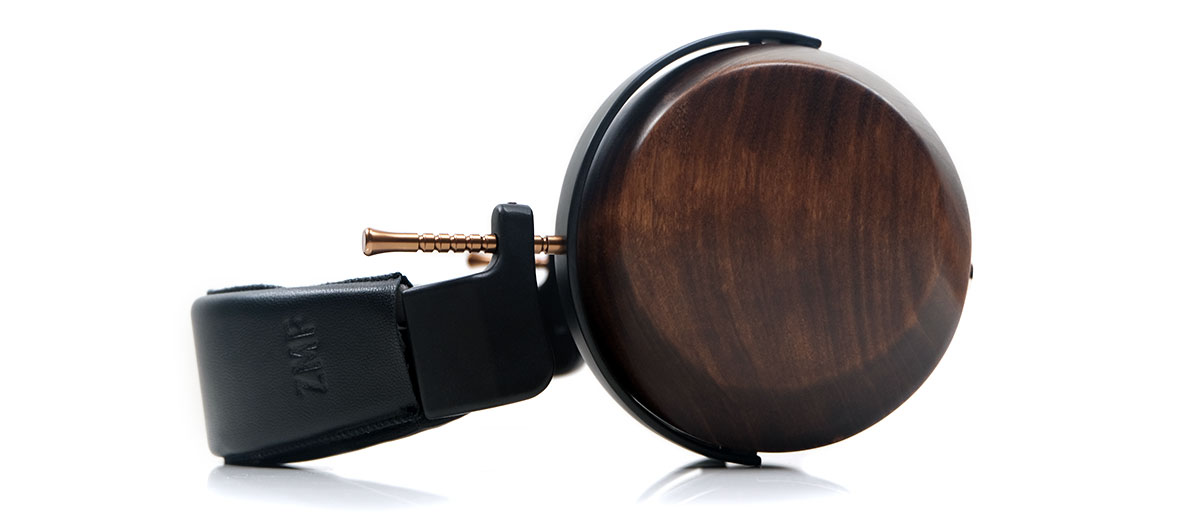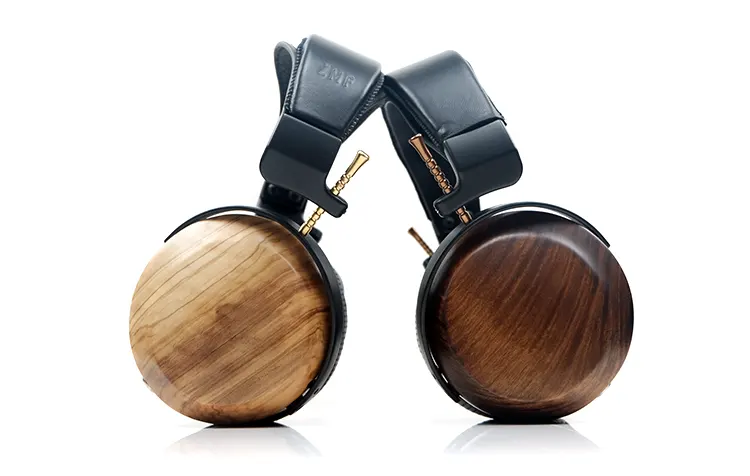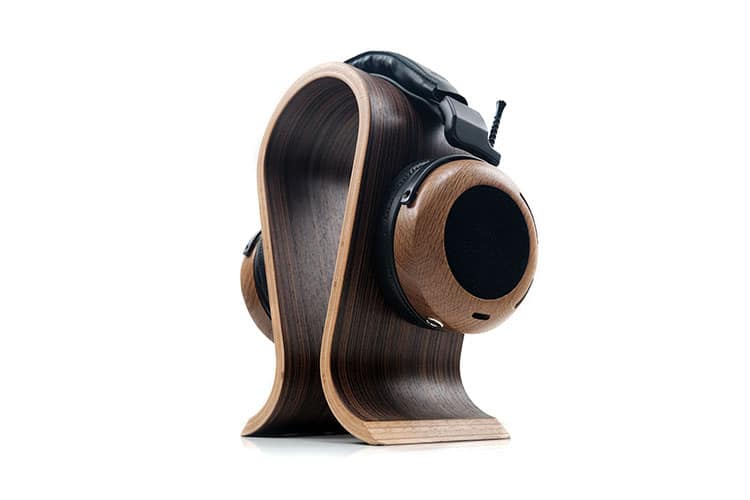Select Comparisons
The following impressions were compiled using a Ferrum OOR/HYPSOS amplifier/PSU in combination with a Ladder Schumann R-2R DAC and the Cayin N7 as the source in I²S mode. All headphones were fitted with their stock pads and cables during this time.
ZMF Headphones Atrium Closed LTD
$2899
Launched at the same time as the stock Cherry Wood edition, the Closed LTD retails a little higher at $2899, is made of Italian Olivewood, and is being sold in more limited quantities.
Technical
The internals of the Atrium Closed LTD is precisely the same as the stock edition with that 50mm bio-cellulose dynamic driver and an N52 rare earth magnet system.
It also means the same ADS acoustical design approach with gradual diffusion including the externally perforated Caldera thin lambskin pads with a narrower surface contact area and wider inner cavity opening.
Both headphones have the same specifications for load at 300Ω impedance with a matching 96dB/mW SPL rating.
What is different is the use of olivewood over the stock cherry wood. Aside from a different aesthetic, (read below), it also has a different material property being a hardwood as opposed to the softer cherry wood.
That does affect the sound signature of the Atrium Closed LTD which you can read more about in the performance section below.
Design
If anything, the Atrium Closed Italian Olivewood is even more attractive compared to the aged and darker mahogany cherry wood though the natural cherry edition might be a little closer to that olivewood color.
The finishing is slightly different with a natural hard wax oil but it still looks low profile in terms of glossiness so the tactile experience of running your hand over both of those gorgeous cup designs feels quite similar.
Rather, it’s the bolder grain lines of the lighter-toned olivewood that stand out for me combined with those very shiny brass rods. They actually look great side by side but if I am going blind and just picking the one that stands out visually then it is the Italian olivewood edition that does it for me.
The other change is the Atrium Closed headband strap with the LTD using the ZMF B.B.B. strap which has a wider thicker leather finished in green, (other colors available). It just had to be green, one of my favorite colors.
Yeah, it clashes a little with the otherwise monotone black of the entire headband system but the wider and thicker strap dimension actually performs better than the stock cherry wood version for comfort.
One thing to note is that this is a heavier headphone compared to the stock Atrium Closed. Around 60-70g heavier and you can feel that slightly on your head and in your hand when A/B’ing them. Not so much as to upset the generally good balance of the headphones though, perhaps the wider headband strap on the LTD is a factor there.
Performance
The best way to explain the differences here is that they have the same broad sound signature, however, the Cherrywood Atrium Closed sounds like it’s being amplified by a SET tube amplifier and the Olivewood LTD is the solid-state version.
The differences primarily reside in the technical domain with some nuanced timbral changes. The first is the urgency of the Atrium Closed LTD, particularly the low-end.
The cherry wood extends deep but it delivers with a more relaxed definition, with less of a mid-bass punch and a bit more decay in the resulting notes. The bass is equally as deep but more atmospheric or diffused than in your face.
The Atrium Closed LTD is by far the more dynamic, tighter, and punchier of the two headphones at the low end. Vocal imaging is also closer with details more palpable sounding whereas the stock cherry wood pulls back a little more, pushing some additional space between you and the stage; just how I would expect a SET to perform compared to a solid-state rectifier.
I do think you give up a little bit of the staging spaciousness with the Olivewood LTD which projects a bit closer but the imaging for me is just as good as the stock Atrium Closed edition.
I did start to wonder though if it’s not just the wood but the fitting creating some of the differences. The LTD does seem to be a better fit on my head with that thick olive-green headband. Perhaps the seal is more aggressive which might be another factor in why I perceived the entire sound signature to be more energetic and imaging a little closer also.
ZMF Headphones Atrium Open
$2499
The Atrium Open is the legacy unit upon which the Atrium Closed stock and LTD are based and was reviewed by us last year. You can read our full review of the Atrium here.
Technical
As with the LTD, the Atrium Open also uses the same 50mm bio-cellulose dynamic driver and an N52 rare earth magnet system as the Atrium Closed. However, the closed cup design necessitates a different approach to the acoustic space, with particular reference to the Atrium Dampening System or ADS.
In the Atrium Open, ZMF places the damping front and center and combines with multiple meshing techniques as well as a more aggressive venting profile in the cups to control the back-wave acoustical response to achieve the desired target response.
The Atrium Closed is more about that gradual diffusion technique with reduced venting and more emphasis on reducing the potential for standing wave problems.
There is more of a distance between the damper and the acoustical materials to create more space between it and the driver as well the introduction of new pads with a bigger inner cavity, thinner contact area, and perforations on the external sides to diffuse sound wave energy excesses.
Both headphones have the same specifications for load at 300Ω impedance with a matching 96dB/mW SPL rating. Any difference you perceive will more likely come from the improved isolation from the Atrium Closed and their differing sound signatures.
Design
Both headphones use the same cherrywood in stock format with matching headband builds. However, the Atrium Open sample we have here is the natural finish whereas the Atrium Closed version sample sent to us is the darker mahogany-aged version.
You can actually get both in the same cup material but it is interesting to see the contrasting aesthetics side by side with the bolder stronger grain streaks in the mahogany-aged Atrium Closed and the lighter glossier tones of the naturally finished open version.
Other variations in the finish include the coffee-gold adjuster rods on the aged finish and the all-black rods on the natural finish. Both look great but my preference is for the coffee-gold rods which stand out a bit more when placed side by side.
The standout for the open edition are those grills which also come in aged copper to match the aged cherry wood finish version or in this sample, stock aluminum material finished in matt black.
The grill finish is quite intricate with the Amiens influence Rose Window gothic inspiration heavily invoked in the machine work.
The pads are different also. The Atrium Open uses a broader contact surface with perforations on both the inner and outer walls. The Atrium Closed thin Caldera pads only have perforations on the outer and they also have a thinner surface contact area with a wider opening.
You can feel that difference in the pad opening on your head. Quite apart from the superior isolation from the Atrium Closed the new pads actually feel a little roomier and comfier.
Performance
You should not have too much difficulty telling these two apart. The Atrium Open has a better staging performance, sounding more open and holographic especially for width and height whereas the Atrium Closed is superior for depth and sub-bass presence/power.
That being said, the Atrium Closed does not sound too limited by its ‘4-walls’ and the spacing is very good but you will feel the expanse of the Atrium Open stage become more rounded with a contextually more intimate imaging experience for higher-pitching instruments and vocals.
The timbre for me is different. There is of course a better fundamental on the Atrium Closed courtesy 20-60Hz lift so most instruments registered on the mid-to-upper bass are going to have more of a planted feel to their tone, a little bit denser.
However, the Atrium Open sounds richer and a bit thicker through the mids with no real drop from 500hz up to 1-2k whereas the Atrium Closed drops a bit more there. You will hear a bit more bass to mids separation from the Atrium Closed and some enhanced instrumental presence and sustain in the lower mids from the Atrium Open.
The treble peaking is a little more conservative for me on the Atrium Open. It has some nudges around 3k and 6k but the general tone is a lot softer creating a lusher richer tone.
The Atrium Closed is more amplified with nodes at 4k and 8k so the treble has more energy and a stronger overtone in the upper mids. Vocals will have more of an edge comparatively speaking but not edgy per se, just a slightly thinner and cleaner tone to them.
ZMF Headphones Caldera
$3499
Technical
Unlike the dynamic driver Atrium Closed, the Caldera is a circumaural open-back planar magnetic headphone.
It uses an 80mm planar driver with a 61mm active moving surface area all encased in a carbon fiber baffle to keep the weight from the coil and magnet array down to a fairly comfortable level.
The 4 traces and 8 pathway patterns are gold-plated copper rather than aluminum and might go some way to explaining its 60Ω impedance rating but still significantly lower than the Atrium Closed 300Ω rating. Surprisingly, the SPL of both is almost the same with the Caldera at 95dB/mW or just 1dB less than the Atrium Closed.
The Caldera diaphragm also has a special silver coating to maximize excursion along the traces. ZMF does not reveal the Caldera diaphragm’s thickness so you won’t hear terms such as nano-grade thickness being bandied about.
Both headphones use an N52 neodymium magnet structure though the Caldera is more typical of a planar with a dual-sided array or CAMS, (Caldera Asymmetrical Magnet Structure), using trapezoidal-shaped magnets.
The Caldera does use an adapted ADS damping system from the original Atrium design that focuses on reducing back-wave cancellation. It has a more uniform application of pressure exerted via a controlled angle or radius of the damping material.
Design
The form factor is the same with both of these headphones. They use the same yolk, pivot block, and headband design with the same leather for the pressure strap and headband outers.
Because the Caldera is an open back, it does use a grill finish in the center of an open cup combined with more numerous aggressive venting port openings.
The grill is beautifully detailed and a little bit denser in terms of open spacing between the lattice-like flow of the material compared to the more open-looking Atrium Open grill design.
Like the Atrium Closed you can get the Caldera in multiple finishes such as a darker aged oak as opposed to Mahogany-aged cherry wood. You can also vary the rod finish with both headphones being offered with a coffee-gold finish.
The sample we have here is a white oak cup combined with the standard all-black finish for the roads similar to the Atrium Open. It is coloration is somewhere in between the natural cherry of our Atrium Open sample and the mahogany-aged alternative on the Atrium Closed.
The weight is not that different between these two samples with maybe 10g maximum so they handle and feel almost the same on the head for heft.
However, depending on the material choices the Caldera weight can jump up as high as 550g, and in the case of the Kingwood Edition you are dealing with 600g, (Magnesium), and 630g, (aluminum), which is fairly hefty. You will not find a current Atrium variant much higher than 520g no matter what finish you choose.
The Atrium Closed pad is called the Caldera thin pad so it’s no surprise they are almost exact matches in terms of material, a wider inner opening, and an outer perforated finish with a solid inner wall.
Performance
A lot of significant differences here, not least an open back versus a closed back and a dynamic driver versus a planar driver. You will hear a different quality of texture from each headphone’s driver as well as a different overall coloration and staging performance.
For a start, the Caldera is a shade more neutral in timbre compared to the warmer Atrium Closed. It has the more linear bass tuning running fairly flat but extended from 20Hz up to around 1k whereas the Atrium Closed is more elevated, picking up a bit more bloom and warmth through the mid and upper bass.
That warmth colors the Atrium Closed mids a bit more for me so they sound the sweeter of the two whereas the Caldera is more forward in the mids around the 2-3k and closer to the Harman Target Response curve here with a gentle lift pushing some vocal pitches further forward.
Both have an 8k node in the treble which shines through a bit more compared to the Atrium Open but the Caldera runs flatter from 4-6k so it comes through a bit more as a wispy sparkle than anything edgy through the upper mids.
Neither is going to stress you out though for sharp percussion splashiness and vocal sibilance and you can extend the Atrium Closed’s presence in the highs even more by switching to the suede pads.
Technically, the transients and general levels of articulation and perceived speed are superior on the Caldera. Notes sound tighter with better low-end separation and of course, the imaging is more expansive with that open-back design.
Neither cast the same level of holographic capability as the Atrium Open but the Caldera will sound more spacious than the Atrium Closed.
Our Verdict
The ZMF Headphones Atrium Closed not only looks beautiful but also has some excellent audio chops to back it up.
It retains the hallmarks of the original Atrium’s generally smooth and slightly euphonic overtone but adds power and body on the low end. Importantly, for a closed-back headphone, it sounds spacious with very little congestion throughout.
But there is a bonus, the LTD or the Olivewood version, which for me really delivers on what I truly like to hear from a closed-back headphone and that is energy and power but at the same time remaining tight and controlled.
Of the two, the Olivewood hits my personal preferences whereas the stock Cherry Wood will appeal to those wanting a fatter sub-bass tuning but retaining that overall relaxed Atrium Open presentation.
I am told though by ZMF that future hardwood, (and softwood), versions will be released in time that will generally perform the same as the Olivewood so do not panic if you are not able to get one now.
Either way, choice is king here and both headphones deliver an impressive closed-back dynamic driver headphone presentation. Just ‘pick your poison’ so to speak.
ZMF Headphones Atrium Closed Specifications
- Impedance: 300Ω
- Driver: Biocellulose N52 Atrium Tuned Driver
- Weight: 480g ± 30g (aluminum chassis, black grille/rods)
- MAG Chassis reduces weight by 34g
- Sensitivity: ~96dB/mW






